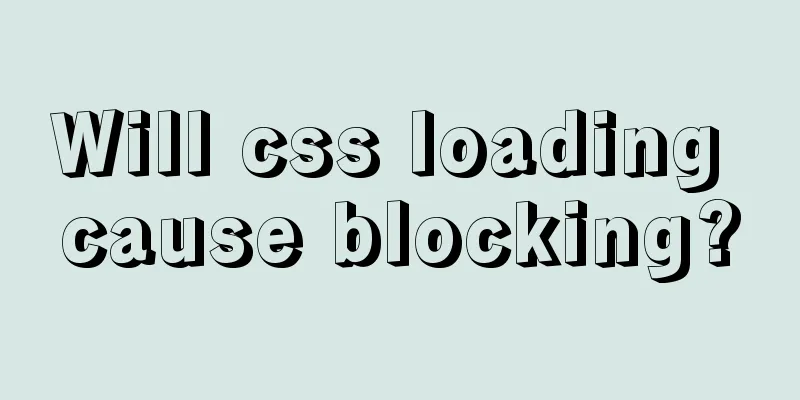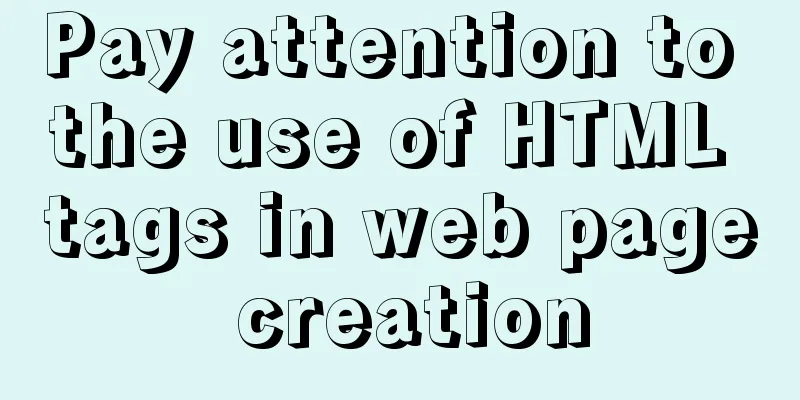Will css loading cause blocking?

|
Maybe everyone knows that js execution will block the parsing and rendering of the DOM tree, so will CSS loading block the parsing and rendering of the DOM tree? Next, I will test the impact of CSS loading on the parsing and rendering of the DOM tree. In order to complete this test, let's first learn how to use Chrome to set the download speed \1. Open the Chrome console (press F12), you can see the following picture, the focus is where I draw the red circle
Click on the red circle (No throttling) and you will see the following picture. We select the GPRS option. \2. Click on the red circle (No throttling), and you will see the following picture. We select the GPRS option
In this way, our download speed limit for resources will be limited to 20kb/s. OK, let's get to the point. 3. In this way, the upper limit of our resource download speed will be limited to 20kb/s. OK, let's get to the point. Will css loading block the parsing and rendering of the DOM tree? Let's talk code:
<!DOCTYPE html>
<html lang="en">
<head>
<title>css blocking</title>
<meta charset="UTF-8">
<meta name="viewport" content="width=device-width, initial-scale=1">
<style>
h1 {
color: red !important
}
</style>
<script>
function h () {
console.log(document.querySelectorAll('h1'))
}
setTimeout(h, 0)
</script>
<link href="https://cdn.bootcss.com/bootstrap/4.0.0-alpha.6/css/bootstrap.css" rel="stylesheet">
</head>
<body>
<h1>This is red</h1>
</body>
</html>Assumption: CSS loading will block DOM tree parsing and rendering Assumption: Before bootstrap.css is loaded, the following content will not be parsed and rendered, so what we see at first should be a white screen, and h1 will not be displayed. And the result of console.log should be an empty array at this time. Actual result: as shown below
Will css block DOM tree parsing? From the above figure we can see that when css has not been loaded, h1 is not displayed, but the console output is as follows
It can be seen that at this time the DOM tree has at least been parsed to h1, but the CSS has not been loaded yet, which means that the CSS will not block the parsing of the DOM tree. Will css loading block DOM tree rendering? From the above picture, we can also see that when the CSS has not been loaded, the page displays a white screen. The red font is not displayed until the CSS is loaded. In other words, although the following content is parsed, it is not rendered. Therefore, css loading will block DOM tree rendering. My personal evaluation of this mechanism In fact, I think this may also be an optimization mechanism of the browser. Because when you load CSS, you may modify the style of the following DOM nodes. If the CSS loading does not block the DOM tree rendering, then after the CSS is loaded, the DOM tree may have to be redrawn or reflowed, which causes some unnecessary losses. So I simply parse the structure of the DOM tree first, do the work that can be done, and then after your CSS is loaded, render the DOM tree according to the final style. This approach will indeed be better in terms of performance. Will css loading block js running? From the above inference, we can conclude that CSS loading will not block DOM tree parsing, but will block DOM tree rendering. So, will css loading block js execution? Again, verify this through code.
<!DOCTYPE html>
<html lang="en">
<head>
<title>css blocking</title>
<meta charset="UTF-8">
<meta name="viewport" content="width=device-width, initial-scale=1">
<script>
console.log('before css')
var startDate = new Date()
</script>
<link href="https://cdn.bootcss.com/bootstrap/4.0.0-alpha.6/css/bootstrap.css" rel="stylesheet">
</head>
<body>
<h1>This is red</h1>
<script>
var endDate = new Date()
console.log('after css')
console.log('time passed' + (endDate - startDate) + 'ms')
</script>
</body>
</html>Assumption: CSS loading will block the subsequent JS running Expected result: The js code after the link should be executed after the css is loaded. Actual Result:
From the above figure we can see that the js code before the css loading statement is executed first, but the code after the css loading statement is not executed until the css is loaded. This also shows that CSS loading will block the execution of subsequent JS statements. See the following figure for detailed results (css loading took 5600+ms):
in conclusion From the above, we can draw the following conclusions:
Therefore, in order to avoid users seeing a long white screen time, we should increase the CSS loading speed as much as possible, such as using the following methods:
Principle Analysis So why does the above phenomenon occur? Let's analyze it from the browser's rendering process. Different browsers use different kernels, so their rendering processes are also different. There are currently two main ones: WebKit rendering process
Gecko rendering process
From the two flowcharts above, we can see that the browser rendering process is as follows: Parse HTML files to generate DOM Tree, parse CSS files to generate CSSOM Tree. Combine Dom Tree and CSSOM Tree to generate Render Tree. Render and draw according to Render Tree and render pixels to the screen. From the process we can see
DOMContentLoaded For browsers, there are two main events for page loading, one is DOMContentLoaded and the other is onLoad. There is nothing much to say about onLoad. It will only be triggered after all resources of the page are loaded. These resources include css, js, pictures, videos, etc. DOMContentLoaded, as the name implies, is triggered when the content of the page is parsed. Well, as we discussed above, css will block Dom rendering and js execution, and js will block Dom parsing. Then we can make the assumption that
Let's test the first case first:
<!DOCTYPE html>
<html lang="en">
<head>
<title>css blocking</title>
<meta charset="UTF-8">
<meta name="viewport" content="width=device-width, initial-scale=1">
<script>
document.addEventListener('DOMContentLoaded', function() {
console.log('DOMContentLoaded');
})
</script>
<link href="https://cdn.bootcss.com/bootstrap/4.0.0-alpha.6/css/bootstrap.css" rel="stylesheet">
</head>
<body>
</body>
</html>The experimental results are shown in the figure below:
From the animated picture, we can see that the DOMContentLoaded event has been triggered before the css is loaded. Because there is no js code behind the css. Next, we will test the second case. It is very simple. Just add a line of code after the css.
<!DOCTYPE html>
<html lang="en">
<head>
<title>css blocking</title>
<meta charset="UTF-8">
<meta name="viewport" content="width=device-width, initial-scale=1">
<script>
document.addEventListener('DOMContentLoaded', function() {
console.log('DOMContentLoaded');
})
</script>
<link href="https://cdn.bootcss.com/bootstrap/4.0.0-alpha.6/css/bootstrap.css" rel="stylesheet">
<script>
console.log('Is it my turn yet?');
</script>
</head>
<body>
</body>
</html>We can see that the DOMContentLoaded event is triggered only after the css loading is complete. Therefore, we can conclude that: If there are both css and js in the page, and js is behind css, the DOMContentLoaded event will be executed after css is loaded. In other cases, DOMContentLoaded will not wait for CSS to load, and the DOMContentLoaded event will not wait for other resources such as pictures and videos to load. The above is the full content of this article. I hope it will be helpful for everyone’s study. I also hope that everyone will support 123WORDPRESS.COM. |
<<: How to use the EXPLAIN command in SQL
>>: Several ways for Vue to achieve communication between components (multiple scenarios)
Recommend
Windows 10 1903 error 0xc0000135 solution [recommended]
Windows 10 1903 is the latest version of the Wind...
The process of building lamp architecture through docker container
Table of contents 1. Pull the centos image 2. Bui...
Methods for backing up Windows server files locally, Windows server data backup solutions
Important data must be backed up, and must be bac...
How to change fixed positioning of child elements to absolute positioning by CSS3 transform
This article introduces the method of using CSS3 ...
JavaScript to achieve drop-down menu effect
Use Javascript to implement a drop-down menu for ...
43 Web Design Mistakes Web Designers Should Watch Out For
This is an article about website usability. The a...
Solve the problem that VMware cannot install 64-bit operating system in win10 home version
Problem Description When VMware Workstation creat...
Mini Program Custom TabBar Component Encapsulation
This article example shares the specific code for...
Tutorial on disabling and enabling triggers in MySQL [Recommended]
When using MYSQL, triggers are often used, but so...
Example code for implementing image adaptive container with CSS
There is often a scenario where the image needs t...
MySQL knowledge points for the second-level computer exam mysql alter command
Usage of alter command in mysql to edit table str...
Detailed analysis of the syntax of Mysql update to modify multiple fields and
When updating a record in MySQL, the syntax is co...
Solve the problem of Linux FTP anonymous upload and download starting automatically
If you often use FTP server in your study or work...
How to install Docker on Windows 10 Home Edition
I recently used Docker to upgrade a project. I ha...
MySQL implements a function similar to connect_by_isleaf MySQL method or stored procedure
Recently, there is a particularly abnormal busine...


















